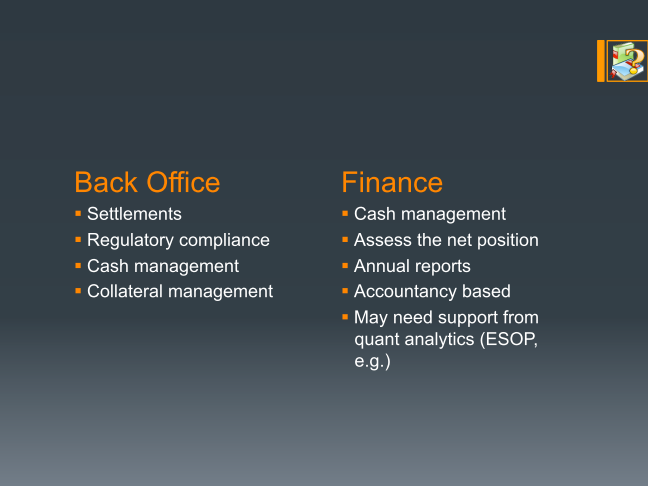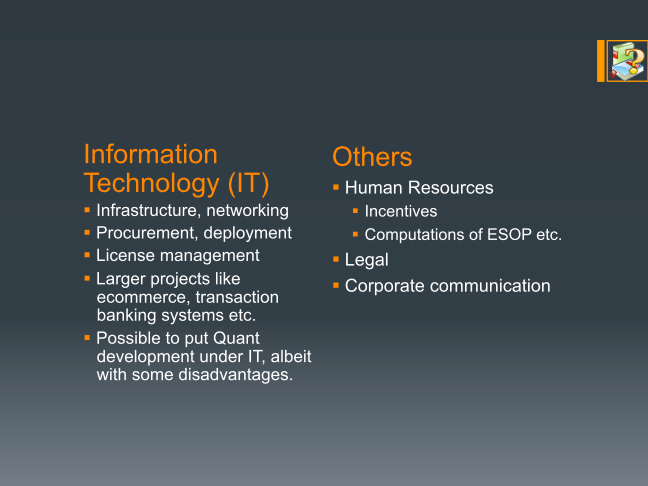From the quant and quantitative development perspective, Back Office is a distant entity. Their role is vital in the trade lifecycle, as we shall see later, but they are outside the sphere of influence of the quants and developers.

Back Office concerns itself mainly with trade settlements and accounting. Upon maturity, each trade generates a settlement trigger usually with the help of a vended trading or settlement platform, which will be picked up and acted upon by the Back Office professionals. They also take care of cash and collateral management.
Finance functions are closely related to Back Office operations. Among a host of accounting related operations, they have one critically important task, which is to produce annual reports. These reports get publicly scrutinized and determine everything from the stock price to performance bonuses, salary levels etc. Finance professionals may require quant and analytic help for certain tasks. In one of my previous roles, I was asked to estimate the fair market value of the employee stock options (ESOP) for the purpose of accounting for them in the annual reports.
The process of pricing ESOP is similar to (although a bit more complicated than) normal call option pricing. Among other things, you need the volatility of the underlying stock in order to calculate the price. I used the standard exponentially weighted moving average method to estimate it from the published stock prices over the previous two years or so to compute it because that was all the data I had access to. Before that time, there was some corporate action and stock ticker name had changed (or did not exist, I don’t remember which). In any case, I knew that the impact of adding more data prior to that date would be negligible because of the exponentially diminishing weights; it would be much less that the round off error in quoting the price to four decimal places, for instance. But the accountant who was asked to look at the computation was upset. She came to me with her rulebook and referred me to page 57, paragraph 2, where it was specified that I was supposed to use ten years for the EWMA computation. I tried, in vain, to explain to her that I couldn’t. She kept saying, “Yeah, but page 57, para 2….” I went on to explain why it didn’t really make any difference. She said, “Yeah, but page 57, para 2….”
Accountants and Finance professionals can be that way. They can be a bit “technical” about such things. In hindsight, I guess I was being naive. I could have just used a series of zeros to back-populate the missing eight years of data (after all, if the ticker price was not quoted, it is zero), and redone my ESOP valuation, which would have given an ESOP price identical to what I computed earlier, but this time satisfying both Finance and the quants.

A team which quantitative developers work closely with is Information Technology. They are charged with the IT infrastructure, security, networking, procurement, licensing and everything else related to computing. In fact, quantitative development is, as I portrayed it earlier, a middle layer between IT and pure mathematical work. So it is possible for quantitative developers to find themselves under the IT hierarchy, although it doesn’t work to their advantage. Information Technology is a cost center, as are all other Middle and Back Office functions, while Front Office units connected to trading are profit centers. Profit generators get compensated far better than others, and it is better to be associated with them than IT.

